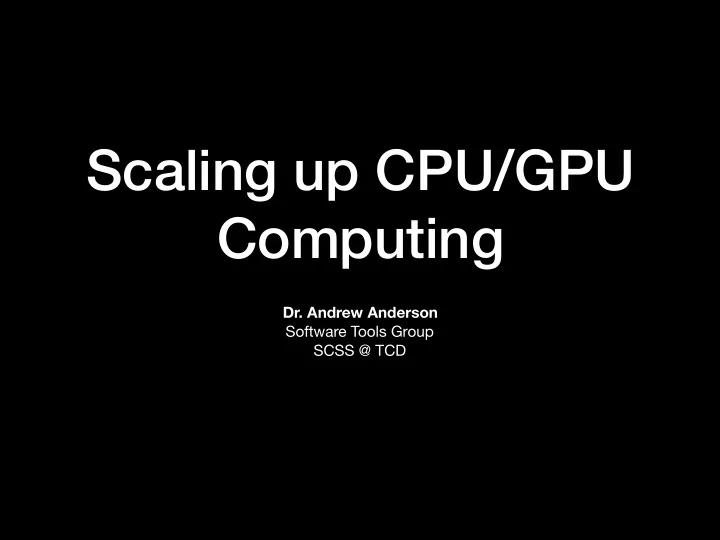

Scaling up CPU/GPU Computing Dr. Andrew Anderson Software Tools Group SCSS @ TCD
How do we measure computing power?
FLOPS (Floating Point operations/ Second)
What is a FLOP anyway? • Nobody really agrees • Hardware manufacturers like big numbers • Commonly accepted usage: • 1 multiply-accumulate (MAC) • 1 fused multiply-add (FMA) 1.2 x 3.0 + 1.0
Climate Change is Real • TOP500 is the list of the 500 most powerful computers • GREEN500 is the list of the 500 most energy-e ffi cient • Ine ffi cient compute resources require lots of cooling • Uses lots of additional power • Have to build data centres di ff erently FLOPS/Watt
How efficient is a human? • ~4.2kj = 1kcal • ~2200kcal = 1 day = ~9.24 x 10^6 j • ~8.64 x 10^4 s = 1 day • 9.24 x 10^6 / 8.64 x 10^4 = ~107W • About two light bulbs or a tenth of a kettle
Class Activity 1.2 x 3.0 + 1.0 1.2 x 3.0 + 2.0 1.2 x 3.0 + 3.0 1.2 x 3.0 + 4.0 1.2 x 4.0 + 2.0 1.2 x 4.0 + 3.0 1.2 x 4.0 + 4.0 1.2 x 4.0 + 5.0 1.2 x 5.0 + 3.0 1.2 x 5.0 + 4.0 1.2 x 5.0 + 5.0 1.2 x 5.0 + 6.0 1.2 x 6.0 + 4.0 1.2 x 6.0 + 5.0 1.2 x 6.0 + 6.0 1.2 x 6.0 + 7.0 1.2 x 7.0 + 5.0 1.2 x 7.0 + 6.0 1.2 x 7.0 + 7.0 1.2 x 7.0 + 8.0
Moore's Law: Transistor count doubles every 2 years But Moore's Law runs into the Quantum Wall at 5nm!
Dennard Scaling: Transistor power is proportional to area • Smaller transistors = less power • But we can ramp up the clock speed • So we get more transistors for equivalent power WIKIPEDIA: Since around 2005–2007 Dennard scaling appears to have broken down. As of 2016, transistor counts in integrated circuits are still growing, but the resulting improvements in performance are more gradual than the speed-ups resulting from significant frequency increases. [2][5] The primary reason cited for the breakdown is that at small sizes, current leakage poses greater challenges, and also causes the chip to heat up , which creates a threat of thermal runaway and therefore further increases energy costs.
Koomey's Law: Efficiency doubles every 1.57 years WIKIPEDIA: "By the second law of thermodynamics and Landauer's principle, irreversible computing cannot continue to be made more energy efficient forever. As of 2011, computers have a computing efficiency of about 0.00001%. [8] Assuming that the energy efficiency of computing will continue to double every 1.57 years, the Landauer bound will be reached in 2048. Thus, after about 2048, Koomey's law can no longer hold."
Physics is in the way!
If we can't have better computers, let's just have MORE computers
A Really Big Computer: ASPIRE @ NSCC 1 PFLOPS System ( 10^15 FLOPS ) • 1,288 nodes (dual socket, 12 cores/CPU E5-2690v3) • 128GB DDR4 RAM/node • 10 large memory nodes (1x6TB, 4x2TB, 5x1TB) 13PB Storage • GPFS & Lustre File Systems • I/O bandwidth up to 500GB/s Accelerator Nodes • 128 nodes with Tesla K40 GPUs Infiniband Interconnection • EDR (100Gbps) full bandwidth within cluster How many humans-equivalent?
Current GREEN500 Top 5
How do we program a computer with >1000 cores? • Short answer: with great di ffi culty • Long answer: we're working on it! Halide Cray IBM
Questions?
Recommend
More recommend